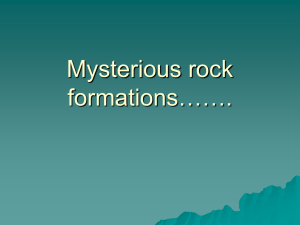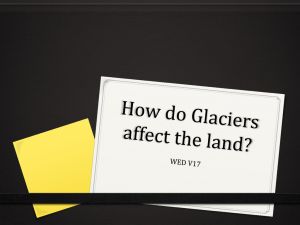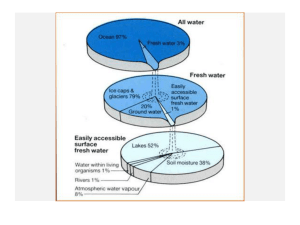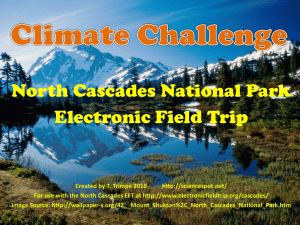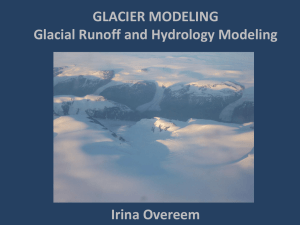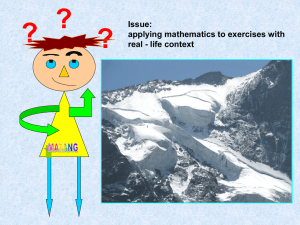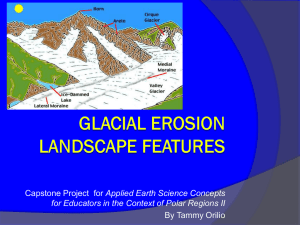ch 15 pp notes Glaciers
advertisement
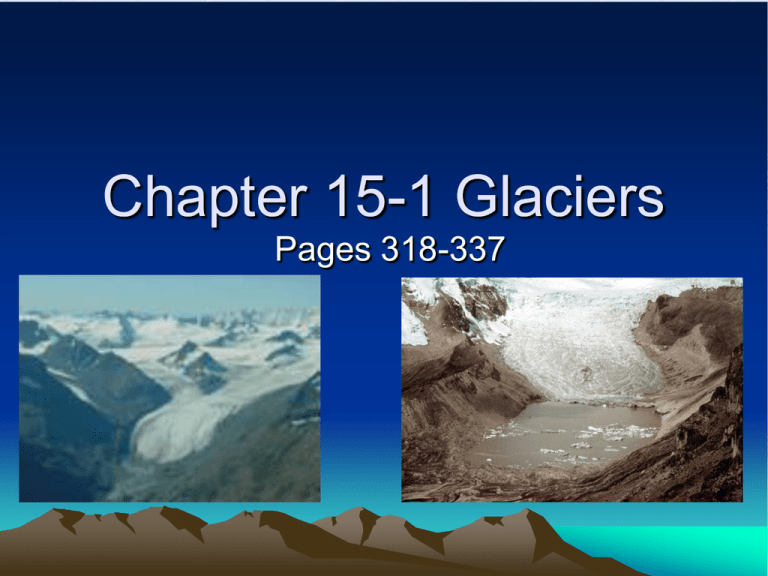
Chapter 15-1 Glaciers Pages 318-337 What is a Glacier? • ¾ of earth’s fresh water is frozen in glaciers. • A Glacier is – • A large mass of compacted snow and ice that moves under the force of gravity Where glaciers form • Form in areas always covered by snow • Snow builds up from year to year • Glaciers may occur in any part of the world – Closer to the equator, the higher the elevation • The lowest elevation at which a layer of permanent snow occurs in summer is called the SNOW LINE How Glaciers form • Mountain basins above the snow line are filled with snow year round. • In these snowfields, buried snow becomes compressed and recrystallizes into a rough, granular material called FIRN or NEVE. Firn • Resembles the ice of a packed snowball • Weight of the firn may turn the lower layers into solid ice. This ice may begin to move outward or downward due to the overlying weight of the firn above – this now is a glacier. Types of glaciers • Valley glacier – Moves within valley walls • Continental glacier – Covers a large portion of a continent Valley glaciers • Forms in the upper valleys of the world’s mountain ranges where snowfall exceeds snowmelt • Under the snow, the firn changes into ice • The ice stays in the valley and slowly begins to move downhill due to gravity • Valley glaciers are also known as alpine glaciers • Valley glaciers occur on all continents except for Australia • Valley glaciers may very small (2km) to very large (100km) and hundreds of meters thick – Large valley glaciers are found in Alaska and Himalayas – Glacier National Park has many remnant valley glaciers Continental Glaciers • In polar regions, large areas are covered in thick masses of ice – Only mountain peaks are visible called nunataks • Are circular or oval in shape – Greenland = 1.7 million km2 and 3 km thick – Antartica = 13.7 million km2 and 4 km thick • Largest C. G. is found in Antartica • A glacier less than 50,000 km2 is sometimes called an icecap – Iceland, Baffin Island, Spitsbergen Ice cap in 1979 and 2003 Glacial Movement and Erosion Ch 15-2 Pages 321-325 How do glaciers move? • Some glaciers move a few centimeters a day, while some move several meters in a week or month? • Move faster after snowy winter, in summer and on steep slopes • Friction differences exist between valley floor and valley walls – why? • A typical glacier will move more rapidly at its surface and center than at its sides. • The heavy weight of the ice above can melt the ice at the base. – This water or slushy layer reduces the friction and may increase the movement of the glacier. This is called basal slip. • Basal slip occurs at the base of the glacier, but does not account for the rest of the glacier’s movement. • Basal slip does not occur in extreme cold Plastic flow • In the interior of a glacier, the grains of ice may deform, or change shape, due to the pressure of the snow and ice above. • Near the bottom of the glacier, the grains are almost flat and can allow grains to slip past one another to create forward movement. crevasses • When glaciers move over a steep downward change of slope, the ice is rigid and crevasses or deep surface cracks form. • Are rarely larger than 50 meters deep How do we study glacial movement? • Scientists will study glacial movement by placing a row of stakes across a glacier to study its movement. • Also use satellite data to track glacial movement and positioning over time. Ice front • The ice front occurs where the glacier’s ice melts as fast as it moves. • A glacier continually is moving forward due to gravity Icebergs • Where the snow line is close to sea level, glaciers meet the sea. • As the glacier moves into the sea, large blocks of ice break off - this is called calving • Occurs in Antartica, northern Alaska, Siberia How Glaciers Cause Erosion • Glaciers are very powerful agents of erosion. • Remove loose rock from valley walls (from fine powder to house-size boulders) and transport this material until it is deposited. • Some material may fall on top of glacier, become apart of the glacier, or be dragged beneath the glacier. • When this unsorted and unstratified rock material is deposited by a retreating, or melting glacier, it is called TILL • The accumulation of till is called a MORAINE • With Valley glaciers, material may be deposited on the sides of the glacier – forming a lateral moraine • If two valley glaciers meet to form a single glacier, the lateral moraines may combine to form a medial (middle) moraine. • When clay and silt particles are mixed by a glacier by the crushing of rock below the glacier, it forms ROCK FLOUR • When this rock flour mixes with water, it takes on a milky white appearance and this meltwater is called GLACIAL MILK • When rocks pieces frozen into the glacier cut away at existing bedrock on the valley floor and walls, it may leave behind long parallel scratches called STRIATIONS – Striations show the general direction of the glacier • Glaciers may also remove large sections of softer bedrock material from the valley walls through process called PLUCKING – This is caused by melting and refreezing if the glacier along this material, and it tends to pluck the softer bedrock from the valley wall. Effects of Erosion • Glaciers may leave behind characteristic formations: 1. Roches Moutonnees – is an outcropping of bedrock that looks like a flock of sheep from a distance 2. Valley glaciers often erode a river valley from a typical Vshaped valley into the classic Ushaped glacial valley. • 3. Main valley glaciers are larger than their tributary glaciers, and erode the valley more as well. – Forms a deeper ushaped main glacial valley than the tributary valleys, this is called HANGING VALLEYS • When a stream is present in the tributary valley, and it now falls into the deeper main valley, this is called a HANGING VALLEY WATERFALL • At the head of a former valley glacier is a semi-circular basin called a CIRQUE • THIS CIRQUE MAY FILL UP WITH WATER AND FORM A SMALL LAKE CALLED A CIRQUE LAKE • When two cirques are formed next to each other, the divide between the two may be narrow and sharp. This divide is called an ARETE • If three or more cirques meet, they will form a pyramidshaped peak called a HORN • Valley glaciers tend to make mountain peaks more jagged and pronounced, while continental glaciers tend to smooth off mountain peaks and leave them polished and rounded.
